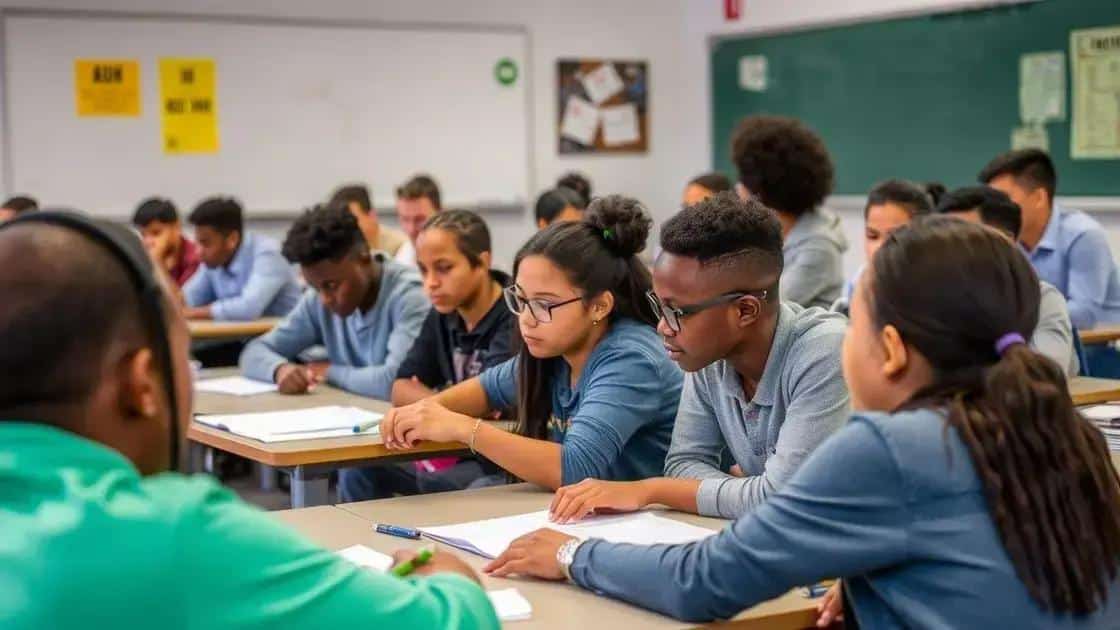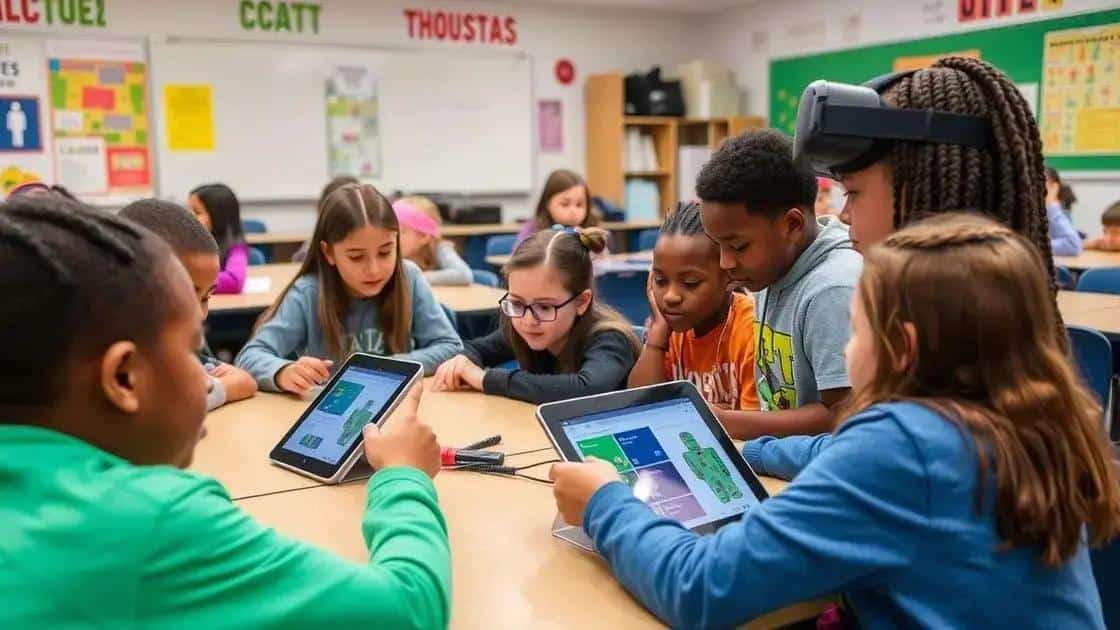Identify curriculum improvement ideas for better learning

Measuring student outcomes and feedback is essential for enhancing curriculum effectiveness, utilizing methods like surveys and data analysis to inform decisions and foster continuous improvement in educational practices.
Identify curriculum improvement ideas that can genuinely enhance the learning experience. Have you ever wondered how small adjustments can lead to significant educational benefits? Let’s dive into actionable strategies that could make a difference.
Understanding current curriculum challenges
Understanding the current curriculum challenges is vital for effective educational reform. Many educators face obstacles that hinder optimal learning outcomes. It’s essential to identify these issues to improve educational practices.
Common Curriculum Challenges
Some widespread problems in today’s curriculum include:
- Lack of alignment with industry standards
- Insufficient inclusion of diverse learning styles
- Limited resources and support for teachers
- Outdated content that doesn’t engage students
These challenges can significantly affect student engagement and learning effectiveness. For instance, when a curriculum is not aligned with industry needs, students may graduate without the relevant skills they need for success. Additionally, a lack of support for teachers leads to burnout, which impacts student learning experiences.
Addressing Curriculum Issues
To effectively address these curriculum challenges, schools and educators must consider strategies that promote collaboration and innovation. Incorporating feedback from teachers, students, and parents helps create a more inclusive curriculum. When all voices are heard, the curriculum is likely to resonate better with the student body.
Moreover, professional development for teachers is crucial. Providing them with training and resources empowers them to handle diverse classrooms effectively. This support can make a significant difference in how the curriculum is delivered and received.
Finally, regularly revisiting the curriculum ensures that it stays relevant. Educational institutions should establish a schedule for curriculum review, making adjustments based on new information, student needs, and societal changes. This proactive approach can lead to a more engaging and effective learning environment.
Engaging stakeholders in curriculum evaluation
Engaging stakeholders in curriculum evaluation is essential for building an effective educational framework. When various voices contribute, the curriculum can be more responsive to the needs of students and the community. This collaboration can include teachers, parents, students, and local businesses, each providing unique perspectives.
Importance of Stakeholder Input
Incorporating feedback from different groups helps ensure that the curriculum is relevant and effective. When stakeholders feel valued, they are more likely to support changes and innovations within the curriculum. This support can lead to a more cohesive educational experience.
Some key groups that should be involved include:
- Teachers: They can share insights on classroom dynamics and student engagement.
- Parents: Their perspectives on curriculum relevance can highlight what students need at home and in the community.
- Students: They can offer feedback on what inspires and engages them during lessons.
- Community leaders: Local businesses and organizations can provide insights into the skills and knowledge required for students to succeed in the workforce.
Gathering input from these stakeholders can take many forms. Surveys, focus groups, and community forums are excellent ways to facilitate discussions. By fostering an open dialogue, schools can identify strengths and weaknesses, leading to informed decisions about curriculum adjustments.
Strategies for Effective Engagement
To effectively engage stakeholders, schools should prioritize transparent communication. When stakeholders are regularly updated about curriculum goals and changes, they feel more included in the process. Moreover, schools should encourage ongoing participation by creating committees or advisory groups.
In addition, hosting workshops or informational sessions can educate stakeholders about the curriculum and its evaluation process. Providing a platform for discussion allows stakeholders to voice their opinions and suggestions freely. This two-way communication is vital for continuous improvement.
Finally, after gathering input, it is crucial to follow up with stakeholders to report on how their feedback was utilized. This demonstrates that their voices matter and can lead to lasting partnerships focused on enhancing the educational experience.
Innovative strategies for curriculum enhancement

Innovative strategies for curriculum enhancement play a vital role in improving student learning experiences. Educators are constantly seeking new methods to engage students and make learning more relevant. By exploring fresh ideas and incorporating technology, schools can transform their curriculum.
Incorporating Technology in Learning
One of the most effective ways to enhance the curriculum is through technology integration. Tools like online learning platforms and interactive software can offer students unique learning opportunities. These technologies enable personalized learning experiences and help address different learning styles.
Some effective technology strategies include:
- Flipped classrooms: Students learn new content at home and apply it in class through collaborative activities.
- Gamification: Using game-based learning techniques to make lessons more engaging and enjoyable.
- Virtual and augmented reality: Helping students explore concepts in immersive environments that enhance understanding.
- Online collaboration tools: Facilitating teamwork among students, even when they are not in the same physical space.
These innovations can make lessons more dynamic and relatable, increasing student motivation and participation.
Project-Based Learning (PBL)
Another innovative approach is Project-Based Learning (PBL). This method allows students to work on real-world problems and projects over an extended period. PBL not only promotes critical thinking but also encourages collaboration and creativity.
In PBL, students can:
- Develop research skills by investigating topics deeply.
- Work in teams, learning valuable communication and collaboration tactics.
- Present their findings to peers, enhancing public speaking abilities.
- Connect classroom learning with community issues or interests.
By making learning hands-on and relevant, PBL captivates students’ attention and fosters a deeper understanding of the material.
Ultimately, by adopting a mix of technological advancements and engaging teaching methodologies, schools can create a more enriching and effective curriculum. These strategies pave the way for a learning environment that prepares students for the future.
Assessing effectiveness of curriculum changes
Assessing the effectiveness of curriculum changes is crucial for improving educational outcomes. When schools implement new strategies, it’s important to measure their impact. This assessment process helps identify what works and what needs adjusting.
Methods of Assessment
Several methods can be used to evaluate the effectiveness of curriculum changes. Testing, surveys, and observations provide valuable insights into how changes affect student learning.
Key assessment methods include:
- Standardized tests: These tests can compare student performance before and after implementing changes.
- Feedback surveys: Gathering feedback from students and teachers helps identify strengths and weaknesses in the new curriculum.
- Classroom observations: Observing classroom dynamics can give insight into how well the curriculum is engaging students.
- Performance assessments: Evaluating students’ projects and presentations can reveal their understanding of the material.
These methods allow educators to gain a well-rounded view of the impact of their curriculum changes.
Data Analysis and Interpretation
After collecting data, the next step is analysis. This process helps educators understand trends and correlations between curriculum changes and student achievement. For instance, if standardized test scores increase after a new strategy is implemented, it may indicate success. Conversely, if feedback shows dissatisfaction, it’s a sign that further revision is needed.
Analyzing student engagement and participation also reveals how well the curriculum resonates with learners. A positive shift in engagement is often a good indicator of effective curriculum changes. Continuous evaluation allows educators to make informed decisions based on specific data.
Finally, involving stakeholders in the assessment process fosters a collaborative environment. Teachers, students, and parents can contribute to understanding the effectiveness of new strategies, ensuring that evaluations consider all perspectives.
Measuring student outcomes and feedback
Measuring student outcomes and feedback is essential for understanding the impact of curriculum changes. By collecting data on how students perform and feel about their learning experiences, educators can make informed decisions that enhance education.
Methods of Collecting Feedback
There are various effective methods for gathering feedback from students. These methods allow teachers to gain insights into student perspectives and needs.
Some common methods include:
- Surveys: Anonymous surveys can help collect honest feedback about the curriculum and teaching methods.
- Focus groups: Small group discussions can provide deeper insights and facilitate conversation about specific issues.
- Exit tickets: Quick assessments at the end of class can gauge understanding and feelings about the lesson.
- One-on-one interviews: Individual discussions allow students to express their thoughts in more detail.
Utilizing these methods ensures that student voices are heard and valued in the educational process.
Analyzing Student Outcomes
Assessing student outcomes is vital for determining the effectiveness of curriculum changes. Data analysis can reveal trends in academic performance, providing insights into how well students are meeting learning objectives.
Key indicators to measure include:
- Standardized test scores: These scores offer a benchmark for student performance over time.
- Classroom grades: Regular assessments help track student progress and understanding of the material.
- Participation rates: Analyzing how actively students engage in class can indicate their enthusiasm for the curriculum.
- Retention rates: Monitoring how many students continue their education can help assess program effectiveness.
Through combining feedback with quantitative data, educators can create a comprehensive picture of how curriculum changes affect student experiences.
Engaging with students and using data-driven approaches allows for continued improvement in teaching methods and curriculum design. The goal is to create an effective learning environment where students feel supported and motivated to achieve their best.
\n
| 📊 Key Actions | 📝 Description |
|---|---|
| Collect Feedback | Use surveys and focus groups to gather insights. |
| Analyze Outcomes | Evaluate test scores and participation rates. |
| Involve Stakeholders | Incorporate input from students and parents. |
| Adapt Curriculum | Make necessary changes based on feedback. |
| Continuous Improvement | Regularly assess and refine the curriculum. |
\n
\n
FAQ – Frequently Asked Questions about Measuring Student Outcomes and Feedback
Why is measuring student outcomes important?
Measuring student outcomes helps educators understand the effectiveness of curriculum changes and ensure they meet student needs.
What methods can be used to collect student feedback?
Methods like surveys, focus groups, and exit tickets can effectively gather valuable feedback from students.
How can data analysis improve the curriculum?
Data analysis reveals trends in student performance, helping educators identify areas for improvement and adapt teaching methods.
What role do stakeholders play in the assessment process?
Engaging stakeholders like students, parents, and teachers fosters collaboration and provides diverse insights for improving the curriculum.






